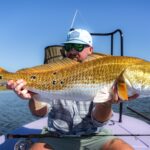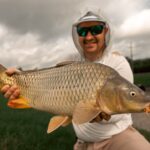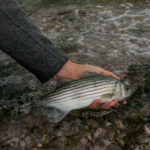
Louisiana Bull Reds Up for Harvest Again: H.B. 604 Must Not Pass
Photo Credit: Carter Abramson | Trevor Johnson Every now and then, we encounter something so
Feature Photo: Striped Bass Magic
The annual migratory behavior of striped bass is incredibly impressive and often under-appreciated. Every spring, stripers navigate a geographical expanse as far south as Virginia up to the coast of Maine, crossing state boundaries, dodging a gauntlet of predators and assimilating into vastly different habitats along their route.
Striped bass hold a special place in the hearts of East Coast anglers, each with their own tale to tell about how they participate in the diverse fishery. Our striped friends have a storied history of management that includes hitting rock-bottom and an impressive rebound. Now, we are steady fight to avoid repeating history. The plight of the striper is something ASGA guides, anglers and supporters know well. A deeper understanding of these fish would put state and coast-wide agencies in a better position to manage stocks effectively and ensure a sustainable future. Our Association is committed to doing whatever it takes to conserve striped bass.
At the recent ASGA Science Symposium hosted in Woods Hole, Scott Bennett, Program Manager of the Marine Biological Laboratory, kicked off the event with a captivating exploration of the hidden lives and scientific intricacies of migratory striped bass. Bennett shared detailed insights into their seasonal rhythms, coastal migrations, and intriguing case studies featuring a cast of “eel pond personalities.”
Shortly after the Symposium, Scott also joined Tony Freidrich, Policy Director of ASGA, on the Guide Post Podcast for an in-depth discussion on their latest research into striped bass. The program originated from observing striped bass returning annually to an “eel pond” to feed on squid used in biomedical testing. This small tidal harbor, located adjacent to the MBL, hosts migratory striped bass in spring and through fall migration, providing a unique opportunity for MBL researchers to study them closely. Remarkably, researchers have observed the return of individual fish year after year.
“The big question is: how do these fish know where they’re going? Right? And so when they leave, say, the Chesapeake, is it a series of ‘I just need to get from this point to this point’? And then ‘if Cape Cod is Point F and the Chesapeake Bay is Point A. Do they need to get to Point B before they can go to Point C? Is it a series of linked chains? If they don’t get to one, they can’t get to the other? Or is it a straight shot? [This is something] that’s kind of unknown.”
~ Scott Bennett on Episode 146 of The Guide Post
Through acoustic telemetry tagging, the MBL team tracks these fish beyond the eel pond, complemented by high-resolution photographic identification of tagged fish, revealing unique stripe patterns that help identify individual fish. This breakthrough supports their collaboration with the GotOne app to develop an artificial intelligence database for enhanced data management and fish identification upon recapture.
The ongoing research promises to deepen our understanding of striped bass lifecycles and movements, crucial for informing policy decisions and improving management strategies. Ultimately, this work aims to ensure thriving fish populations for future enjoyment. For more insights into the research findings, you can listen to Episode 146 of the Guide Post on Apple Podcasts and Spotify:

Photo Credit: Carter Abramson | Trevor Johnson Every now and then, we encounter something so

This past weekend, ASGA proudly sponsored the Dirty Carp Tournament in Louisiana — and no, you didn’t misread that.

After years of data pouring in from The Albie Project, advocacy, persistence, and support from

This morning, the Connecticut Environment Committee held a hearing on House Bill 6248, a bill
We rely on our members and donations to keep fighting for a sustainable tomorrow in marine conservation.
GIVE THE GIFT OF FISHERIES CONSERVATION THIS HOLIDAY SEASON. SHOP ASGA GOODS THAT FUND FISHERIES RESEARCH & ADVOCACY CAMPAIGNS
JOIN ASGA IN CALLING FOR CRITICAL MANAGEMENT ACTION AFTER YEARS OF SPAWN FAILURES & POOR MANAGEMENT.
By using this website, you agree to our use of cookies. We use cookies to provide you with a great experience and to help our website run effectively. To learn more, please review our privacy policy.